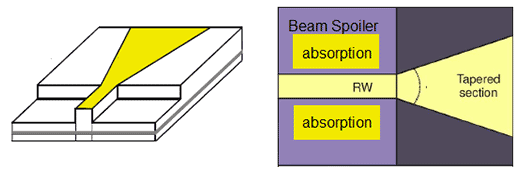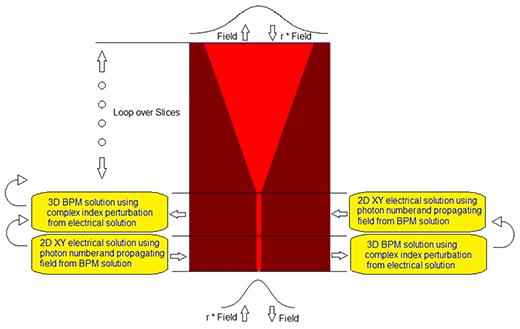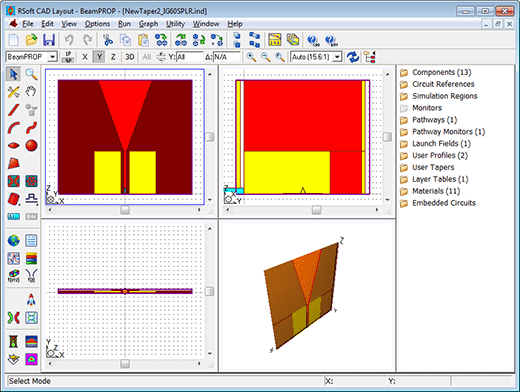Cloud native EDA tools & pre-optimized hardware platforms
Tapered Laser Utility: Modeling High-Power Lasers
High-power semiconductor lasers have many applications ranging from medicine to manufacturing. They can be used directly or as pumps for solid-state or fiber lasers. They can also be grouped in stacks or arrays to increase total output power. Common problems associated with high-power fields in these devices include facet damage, which can limit the total output power, and filamentation, which can reduce beam quality. Many designs have been proposed to overcome these issues, such as tapering one or both facets, using an external cavity, including absorbing regions called beam spoilers to reduce the optical pumping due to backscattering, and using gain-guiding.
Simulation methods for analyzing these designs include the self-consistent combination of 3D beam propagation method (BPM) and electrical transport analysis. This technique generates realistic gain profiles and propagating fields that can be used to study a variety of effects, including filamentation and spatial hole burning. This can help facilitate design optimization, such as finding the optimal taper width or beam spoiler placement, and determine when to use gain-guiding. Several of these configurations are shown in Figure 1.

Figure 1. High-power tapered laser designs: gain-guided taper (shown left) and beam spoilers (shown right).
Figure 2 shows the simulation flow used to analyze these devices. The structure is segmented into a number of slices that are all kept at the same voltage. For each voltage simulated, a mode is calculated for the first slice and then an electrical simulation is performed using that mode profile. The gain at the given voltage produces a complex index profile that is passed back to the BeamPROP BPM solver, which then propagates the field (which may grow or decay depending on the gain) for the length of the slice. This field is then passed to the electrical simulation for the next slice, and so on until the end of the device. At that point, the field is reflected according to the specified facet reflectivities and the process repeats in the backward direction. These bidirectional loops are repeated, while adjusting the photon number, until the field at each facet has converged. The solution for that voltage bias is then known. The photon number determines the optical power emitted and the total current is simply the aggregated current from all the slices. The L-I-V curves can then be constructed from the solutions for a sequence of voltages.

Figure 2. Simulation flow for 3D high-power tapered lasers.
The method described will be used to analyze a gain-guided tapered laser with and without beam spoilers. Far-field results will be shown to compare the beam quality produced by each design. Figure 3 shows the layout of the device in RSoft CAD. The yellow rectangles on either side of the straight waveguide section are the beam spoilers. These are simulated as regions with material loss. The case without beam spoilers is identical, but this loss has been set to zero.

Figure 3. RSoft CAD layout of gain-guided tapered laser with beam spoilers.
Simulation results for the far field are shown in Figure 4. The angular far fields along x and y are shown as contour plots on the left of the figure, while the cross-cuts along x are shown in the right. The results for the device without beam spoilers are shown on the top of the figure, while the results for the device with beam spoilers are shown on the bottom. It is clear that the beam quality is significantly enhanced (more Gaussian) when beam spoilers are included in the design.

Figure 4. Far Field results for the gain-guided tapered laser with (bottom) and without (top) beam spoilers. The full cross-sections are shown left and cross-cuts are shown right.
For more information, please contact photonics_support@synopsys.com.
Download Design Files
References
1. Lim, et. al., ”Design and Simulation of Next-Generation High-Power, High-Brightness Laser Diodes,” IEEE JSTQE, Vol. 15, N. 3, May/June 2009, p.993.
2. Erbert, “Efficiency of diode lasers: Basics and principles of optimization,” Brigther–meeting, Madrid 25th October 2007.
3. Sujecki, et. al., “Nonlinear Properties of Tapered Laser Cavities,” IEEE JSTQE, vol.9, no.3, May/June 2003, p.823a.





